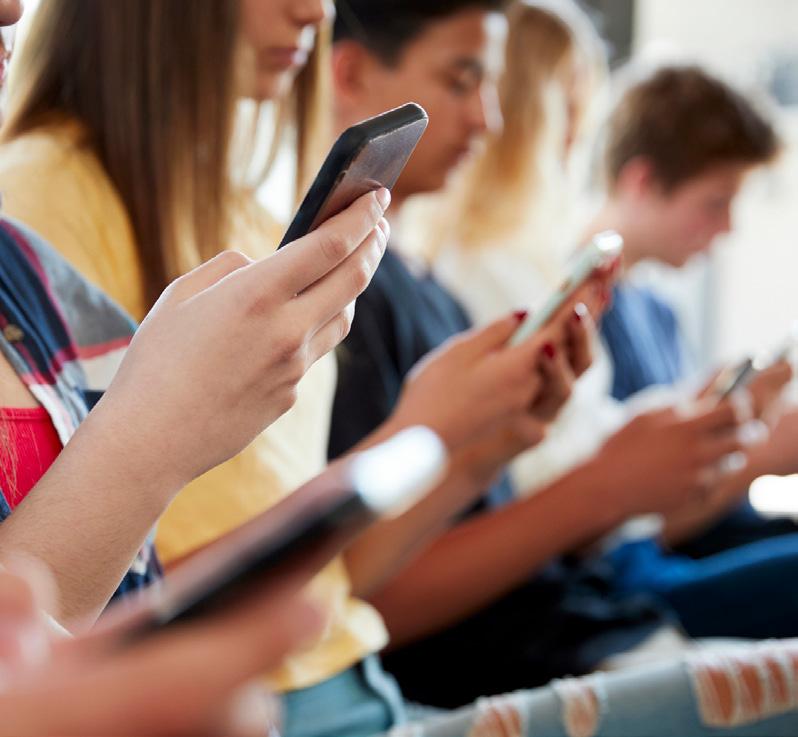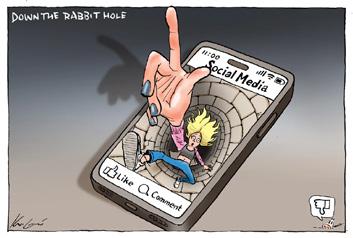

The Decay of Play
How social media has impacted our children, and what we can do to help
The Decay of Play
How social media has impacted our children, and what we can do to help
Rhiannon Ward Research and Development Coordinator Luther College

Unlock. Tap. Tap. Swipe. Down. Across. Lock. These simple hand gestures hold so much authority, don’t they? Unlock your phone screen. Tap to see who has messaged. Swipe to the side – take note of the ‘likes’ on your Instagram account. Tap across, check Tik Tok. And when none of these feeds give you what you want, Lock. It’s as simple as that. Or is it? And what is it that we were searching for in the first place? Approval? Worth? Validation? A combination of all three? I am not here to judge – I am as guilty of this pattern of behaviour as the next social media user – but I am here to shed some light onto what I am coining here as the Decay of Play. I believe that we are in the midst of a social media crisis, and we don’t even really know it yet.
Parents, do you remember a time in your own childhood, when after school or on the weekends you would spend your time emptying the contents of cupboards, building forts in your family lounge room, or throwing a sprinkler under your trampoline and being lost to the bounce for hours? Now, in 2024, my own primary school aged children are lucky if they can stay interested in these things for more than half an hour. Johann Hari, author of Stolen Focus: Why You Can’t Pay Attention attributes our modern short attention span to twelve key causes, with the final reason being ‘the confinement of our children’; (Hari, 2022). Essentially, he argues that these millennial children are unable to play for extended periods of time, and even more troubling, their parents are perhaps unwilling to let them do so. You may recognise this in your own family dynamics, as sometimes a screen is an easier fix than an argumentative teen or a grouchy toddler. However, researchers such as Hari explain that contemporary children have less ability to concentrate for extended periods of time, and they have markedly less imaginative capacity to create something from nothing, than they did even 20 years ago. The reasons for this are certainly complex, but they can at least in part be attributed to the rise of technology use. Quite frankly, what we are experiencing is the Decay of Play, and this White Paper will explore this phenomenon.
The Problem
Whilst talking about the pandemic is now so passe, the fact remains that those years have changed the way that we interact, and the permanent effects of those long, long lockdowns are still being exposed today. Whilst on one hand we understand that a balance of technology and real life human social interaction is necessary and important, our world was flipped for those years and the ratio wildly swung in favour of the screen. Hari unravels the complexity of this throughout ‘Stolen Focus’, but much of his dissertation is based on the tech companies themselves, who are shamelessly using meta data to track us, interact with us, and disrupt us every minute of every day. Anecdotally, Hari refers to a friend ‘Tristan’ who worked for Google over 15 years ago, and even then his friend acknowledged that the company was deliberately and knowingly applying ‘interruptions’, that ‘cause(d) a deterioration in people’s ability to focus and think clearly’, (Hari, 2022), yet the business was booming and in fact was being fed, like a vortex, on this human misery. Fundamentally, we can’t have our cake and eat it too. We can’t allow access to online platforms but then expect this incessant blue light to somehow remain impartial. Just like Alice, adults and children fall down that ‘rabbit hole’ of technology and it can be hard to pull them back up to the surface. Mark Knight, a well-regarded cartoonist and journalist addressed this very idea recently as he wrote that adolescents are ‘becoming addicted to their screens and depressed by witnessing things on social media’, (Knight, 2024), Yet, these teens remain compelled to spiral down this figurative rabbit hole, which is against their better health and judgment.

Mark Knight, 2024
The incessant online connection points not only allow for faceless and cowardly actions like bullying or shaming, but more troublingly, by spending so much time in the online world, it can be hard for people to remember how to interact in their real world. These social disconnections can be seen around our immediate communities, our local neighbourhoods, or our country at large. As a school, we recognised the disconnection that mobile phones were creating amongst our students, and so by enforcing a ‘no phone’ policy during the day, we have essentially opened up the channels of real human connection between our students, again. Technology can be a gift, but it can also be a blockade to appropriate social interaction, and as a Luther community we believe that our approach to the management of mobile phones during the school day is a necessary step to combat this decay. Head of Middle Years, Anthony Coghlan, believes that to, ‘underpin the sound development of social-emotional capacity in our young people, we must balance the setting of screen boundaries with the provision of interpersonal opportunities’ (Coghlan, 2024). Coghlan and his team operate at levering this gentle balance, and he extrapolates further, ‘our values and pedagogy encourage our students to step into the spaces that develop their whole person. We know the role that neuroplasticity plays in these critical years, where repeated actions become habits, which ultimately form core personal dispositions. Our role in a complex world of avatars, notifications and idolism is to build empathy and respect for self and others in the offline world’. Ultimately, the role that social media and screens have in the lives of our teenagers is something that schools and families navigate together, and at Luther we believe that we are managing this harmony with success.
If we know that some sites are more suitable for young children and teens than others, the next natural question to raise is: ‘which platforms are safe, and which are not?’ Parents want to keep their children out of harm’s way, so surely some guidelines to help support families would be easy to find, right? Wrong. Whilst there are suggested age restrictions for certain sites and apps, it remains extraordinarily easy for children to either buck the system and get around the blocks, or alternately, convince ‘their adult’ to fudge the figures for them. The ‘36 Months’ campaign, led by media personalities Michael ‘Wippa’ Wipfli and Rob Gullazzo, explains the challenges with these dangerous platforms, as they explain that an app which encourages addictive features, such as ‘likes’ or continuous scrolls, is ‘out’, and less addictive connective tools such as Messenger or WhatsApp, are ‘in’, (36 Months).

Months
Negative impacts on young people and families
The premise of the ‘36 months’ campaign is that three more years, 36 months, should be added to the age limit that children can legally subscribe to some social media platforms. That is, the limit may raise from 12 to 15, or 13 to 16. These volatile platforms such as Snapchat and Facebook are recognised as addictive, manipulative and hence potentially dangerous for a developing child’s brain, and it is largely accepted that they should be more tightly controlled. Wiplfi claims that these algorithms are ‘selling your kids attention span’, (Wipfli, M., 2024), and our Government must now step up and challenge the ethics behind this. Once unravelled, it can be difficult to reel this focus back in, so it seems about time to put some stops onto this heavy flow of content and data. There is a bank of researchers out there who disagree, and think that a blanket ban or change will not solve the problem but will rather shift it. One such view is shared by Professor Sue Nichols from the University of South Australia, who observes that it can be very hard to ‘carve out a bit’ of digital literacy and tell young people, ‘no, you can’t have it’ (Nichols, 2024). Whilst this seems feasible, perhaps the solution here is a versatile approach, and we need a level of flexibility and parental judgement where these restrictions are concerned. Either way, the time to act is now, and certainly something needs to change.
Broadening our lens to some extent, it is important to consider the ways in which social media and social development are inextricably linked. If we can identify a handful of online applications that are dangerous to individual children, then it follows that there will be rippled negative impacts on our young people, their families, and even our communities at large. There is a set of potentially problematic platforms: X, Tik Tok, Instagram, Snapchat, Instagram, Facebook and even LinkedIn and YouTube, that are considered ‘addictive’, and hence, people are being cautioned against using them too frequently, if at all. The generative nature of the feedback loop means that content follows content, and then more content again, and it can be very hard for a person to break their ‘concentration’ and redirect it in other ways. Children are being manipulated by these platforms, both emotionally and socially, with even their basic manners and ways of interacting with others sometimes becoming warped by the hyper stylised versions of reality glazed across their phone screens at a constant high speed. Again, I hark back to my own childhood, when manners were taught at the dinner table, and we would not be excused to leave until everyone had finished munching on their Chop Sui or Apricot Chicken. In 2024, kinder kids are taken to cafes with Bluey streaming from mum’s phone so that she can hold a conversation without interruption, and families are bunking down on the couch at night instead of sitting up with a set placemat, choosing the Google Box over the human connection. This complete change in human patterns of behaviour is affecting the way that our young people interrelate, and it is certainly something to consider.
Even more broadly, these subtle shifts in family life, in communication, in human interaction can perhaps lead to children developing a more diluted drive to ‘do life’ as a young adult than perhaps was the reality 20 years ago. Parents of teenagers today will often lament that their offspring have no real need or desire to get their drivers’ license, have no real indication that they would like to move out of home, or even travel broadly. Yes, life is expensive, and these activities require capital; second hand cars are costly, rent is high, plane tickets are through the roof. But, even when parents are prepared to pay, their young people are still not prepared to take the chance.
Given all of these complex moving parts, this paradox does seem like a social phenomenon, rather than an economic one. Modern life has evolved and shifted in 20 years, and parents’ relationships with their children have changed. More often these adults are the guiding ‘friend’ as opposed to the autocratic ‘boss’ of the past, and whilst this does have advantages, the downside can be that parents are in fact too involved in all aspects of their children’s lives. These known, overprotective ‘helicopter’ parents, (Bayless, 2024), when at the extreme, will try to control every moment of every day for their children, rather than allowing them the freedom to fall and scratch their knee, roam the neighbourhood on their bikes after school, or jump the back fence to seek the neighbours’ kids for unstructured play. These over-observed children then have the potential to grow into cautious teenagers, who are too worried about ‘what might happen if…..’ to take the calculated risk and try something new. In turn, these nervous adolescents may progress into guarded young adults who stay home for longer than would have been common two decades ago, with no drivers’ license nor motivation to get one, to boot. Whilst we can acknowledge that life is money and money is life, this observation is more connected to the general malaise of many of our youth today, rather than the cost required to obtain these milestones. What happened to working a couple of part time jobs to pull together the money for a roundthe-world Contiki tour? Or saving up the dollars to buy that first 2015 model Hyundai Excel Sprint? Sure, there are some teens out there diligently squirrelling away their dollars to do such things, but the general percentage of people striving to achieve these life goals has certainly declined over time.
Positively, Nielsen CMV data indicated a surge in travel interest among young adults post Covid, but still only 30% of 25-39 year olds at that stage were planning some sort of travel, (Nielson, 2023). This tepid trend is also reflected by the fact that only 57% of Australians held a passport just before the pandemic, with many people feeling ‘fear or responsibilities at home’ as holding an impact in suppressing these international desires (Scott, K., 2019). Luther College recognises the immeasurable benefits of immersing oneself in an international destination, with our Language and Cultural Tours designed to provide students with a window into the life and education of Chinese students, or German families. Head of Languages at Luther, Georgie Collyer, is a strong advocate for such programs, as she believes, that ‘the challenge of being immersed in a different culture and its language is transformative, if young people are willing to withstand the initial disorientation and discomfort. Without direct personal challenges such as this, young people don’t have the opportunity to build resilience and self-confidence’. Collyer and her colleagues work steadily in their Language lessons to build this global context for Luther students, as she fears ‘a growing isolationism among young people and a tendency for them to stick to what they know. Immersive international experiences where students are independent from their home environment could be a powerful antidote to this widespread ‘failure to launch’, which seems so common in our young people now’ (Collyer, G., 2024). Undoubtedly, opportunities for growth exist for our teens today, they just need the motivation to want to try.
It is almost as if technology has made life too streamlined; it has become too easy to seek through the screen, and global activities can be found at the click of a button, rather than having to survive the gruelling two-day flight to the UK and back. The question should be raised; can we ‘blame’ the advent of technology for changing these patterns of behaviour? And if our human interaction is too straightforward to obtain through social media platforms, to the deficient of real-life social experiences, should we be worried? My feeling is, yes, yes we should.
Possible solutions:
So where to from here? Well, to combat the physical blockage of the computer or phone screen, the solution to this problem might be as simple as putting those devices down, and seeking out true human connection again. Real life points of juncture: mentoring programs, youth groups, people contact and social interaction, must be sought out and experienced by our young people and by ourselves if we are to combat the Decay of Play. We must unplug from the device and re-join a reading group, or a sports team, or a walking club. We must deliberately take ourselves away from the Messenger chat screen and book a table for family dinner once a week. Parents can model this behaviour for their children too – return to the dinner table and have ‘tech free time’ when you share a meal together at night. Even bust out the boardgames again, and shuffle a deck of Uno to involve everyone at the table rather than continue the endless screen check. We must stop the cycle: Unlock. Tap. Tap. Swipe. Down. Across. Lock. If we break this chain, we give ourselves the space, time, and energy to perhaps, create a new one: Talk. Smile. Smile. Laugh. Joke. Share. Love. Now wouldn’t that be a positive and fulfilling pathway to the future? I think so – do you?
References
36 Months Campaign: 36 Months
Bayless, K., (2024), What is Helicopter Parenting and How Does it Impact Kids?. Raising Kids website: Helicopter Parenting: Examples, Causes, Effects (parents.com)
Coghlan, A., (2024), Head of Middle Years, Luther College.
Collyer, G., (2024), Head of Languages, Luther College.
Hari, J., (2022), Stolen Focus: Why You Can’t Pay Attention. Published by Bloomsbury. Knight, M., (2024), Social media leaves biggest issues in free fall in Knight’s cartoon, printed online by Kids News: Kids News: Teens tumble down rabbit hole in Mark Knight toon | KidsNews
Nichols, S., (2024), University of South Australia, interviewed on ‘Melbourne Mornings’, (ABC Radio National, 774), June 26th 2024.
Nielson online (2023), Nielsen data reveals Australia’s changing travel trends and the brands spending big to attract Aussie tourists | Nielsen. Accessed July 2024.
Scott, K., (2019) ABC Everyday. Why many Australians don’t have overseas travel on their bucket list - ABC News. Accessed July 20204.
Wipfli, M., (2024), Interviewed on The Project: Push To Not Allow Children Under 16 To Use Social Media (youtube. com). May, 2024.
Luther College
Plymouth Road
Croydon Hills Vic 3136
Phone: (03) 9724 2000
www.luther.vic.edu.au
